Every business needs a marketing strategy. Even if the product or service you’re offering is the best, to be successful, you need a plan on how you’re going to reach your target audience and turn them into paying customers.
In this article, we will go over how to develop a marketing strategy for a company and the advantages of having one in place.
Ready to dive in? Let’s get started.
What Is a Marketing Strategy?
A marketing strategy is a plan used to determine and execute the marketing and sales goals of a business. You might be tempted to think you could jot it down on the back of your notebook and be done with it. In reality, developing a marketing strategy is a complex process that takes into account several different elements, such as:
- Identifying target market segments.
- Conducting consumer and competitor research.
- Setting sales goals.
- Executing promotional and marketing activities.
A solid marketing strategy will set long-term marketing goals and help you streamline how and where to push your marketing efforts. The goal is to take potential customers and influence them to choose your products instead of a competitor’s brand.
Why Develop a Marketing Strategy With Focus on Strategic Orientation?
Developing a successful marketing strategy can help you:
Define Your Target Audience
When you develop a marketing strategy for a new product, you need to define a clear target audience. Too often, businesses end up targeting their ads and promotional material toward an unspecified general audience. This is unlikely to yield positive results because these might not be potential consumers of your products or services. With a marketing strategy in place, you will be better equipped to define, identify, and reach your ideal target customer base.
Invest Your Money in the Right Promotional Channels
There are many marketing channels and platforms that businesses can use to publicize their products and services. However, not every channel will be the right fit for your business.
By following a marketing strategy, businesses can focus their marketing efforts on the right channels for their target audience.
For example, if you are targeting Gen Z users, you are far more likely to see results on platforms like Instagram and TikTok instead of Facebook or Google, which are typically used by older users. Nearly 40% of Gen Z use TikTok and Instagram to do basic online searches instead of Google. So, instead of wasting your resources on a platform that will not give you any returns, having a clear marketing strategy can help you identify channels that are best suited to your business goals.
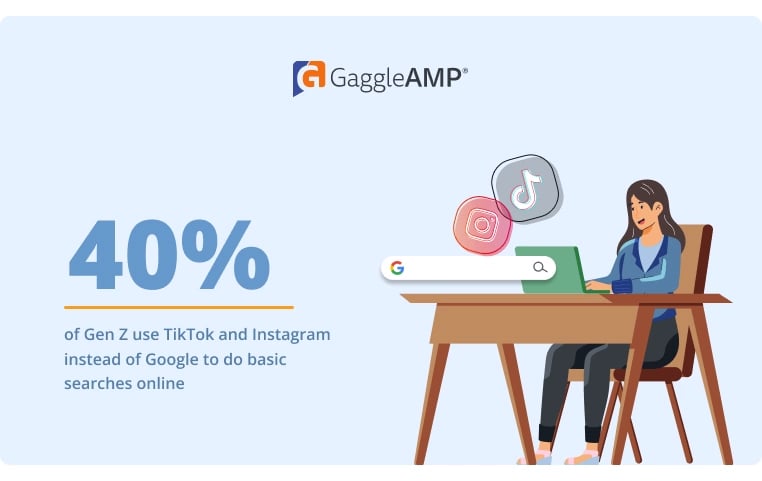
Measure the Outcome of Your Marketing Efforts
When you design a marketing strategy, you set well-defined and quantifiable goals. Metrics such as return on investment (ROI), social media engagement, customer acquisition, website traffic, and conversion rate can help you figure out if you are on the right track.
Use these metrics to refine your marketing activities and avoid errors in the future.
Keep Your Marketing Consistent Across Platforms
A marketing strategy should clearly outline your brand identity and marketing goals. As a result, your content and messaging will become more uniform and consistent across different platforms.
This is important because whether you are posting to your Twitter handle or taking out an ad in a newspaper, your brand identity should remain consistent across different media. Consistency in how you present your brand, how you communicate its messaging, and the visual elements you use in your content across different channels are key to building brand authority and a sense of trust in your customers.
What's it like running a historic alpine refuge in the mountains near Chamonix, France while mothering two young children? Climbers often become impromptu babysitters when it's time to make dinner. pic.twitter.com/ZTzaFgGSdc
— Patagonia (@patagonia) December 15, 2022
Notice how Patagonia isn’t marketing their products in this Twitter Patagonia Story. The brand identity is so strong and consistent that you can tell this is a Patagonia ad without being sold products throughout the video.
Marketing Strategy vs. Marketing Plan
Since marketing strategy and marketing plan are both terms that deal with related aspects of marketing, the two are sometimes interchanged. However, their functions are distinctly different.
A marketing strategy is an overall framework within which your marketing goals are set. It makes use of customer research, competitor analysis, and appropriate marketing channels to lay down marketing intentions and desired outcomes. A marketing strategy connects a brand’s identity, goals, and advertising to effectively communicate with customers so that they can see value in purchasing your company’s products or services.
A marketing plan is a plan of action through which you execute your marketing strategy. This includes plans for how you will run marketing campaigns. For instance, selecting the channels to use, the budget allocated for each, and the metrics to gauge levels of success. Typically, a marketing plan for a specific promotional activity will include details about the marketing content, a well-defined target audience, and a timeline for executing the promotion.
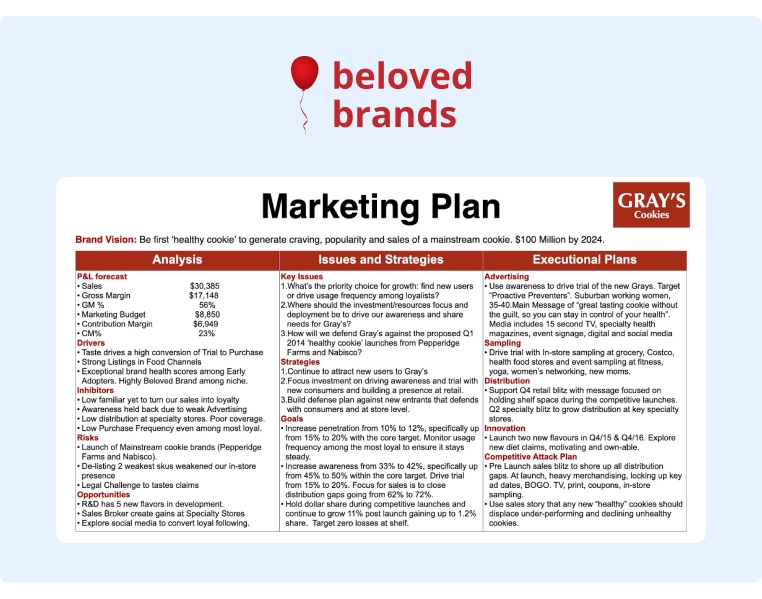
Source: Beloved Brands Step-by-Step Guide for How to Write a Marketing Plan
To sum it up, a marketing strategy is an overarching framework of goals, while a marketing plan is a means to implement promotional activities to achieve those goals.
How To Develop a Marketing Strategy for a Small Business
Developing a marketing strategy is crucial to the survival of startups and small businesses. It is a means of reaching your customer base and pitching your products and services more effectively. Here are five important steps to develop a marketing strategy.
1. Define Your Goals
The first step in developing a marketing strategy is to define your goals. Set marketing goals that align with your short-term and long-term business targets.
If the overall goal is to increase sales at your e-commerce store, your marketing strategy must be oriented towards increasing website traffic or boosting purchases via your social media platforms.
Other common marketing goals include:
- Expanding the customer base.
- Improving brand awareness.
- Boosting engagement on social media.
- Increasing sign-ups for a newsletter.
- Optimizing SEO.
- Achieving greater visibility on a product launch.
2. Define Your Target Customer
You cannot develop a marketing strategy without knowing your target customer. So, the next logical step is to identify as many qualities as you can about your target audience. A great way to do this is to create a buyer persona – a fictional personification of someone representing your target audience. Important factors to consider when creating a buyer persona include:
- Age.
- Gender.
- Educational background.
- Income or purchasing power.
- Location.
- Interests.
- Political and religious affiliation.
- Views and opinions.
You can define your customer persona further by asking questions such as, ”What kind of media are they most likely to use?” or ”What concerns might they have while purchasing your product?” For instance, if you are selling high-end sneakers to Millennials, you would use digital marketing channels like Facebook, Instagram, Twitter, or Snapchat to reach this audience since they utilize these platforms.
3. Research the Market
Understanding the market that you operate in is key to formulating a marketing strategy. A holistic look at recent market trends and potential developments can have a huge impact on how your business runs its promotional activities.
Similarly, you need to study gaps in this market where you could potentially add value with your product or service. Spend time figuring out what makes your offering unique, its features and what problem it solves for consumers. Additionally, you should also consider its price point and compare it with competitors in the market. You can also research the market share your competitors have and analyze their marketing efforts to see what is working well for them. This can help you find ways of incorporating successful elements in your marketing strategy.
4. Choose Your Channels
From traditional channels like newspapers to Facebook ads to SEO marketing, there are multiple avenues for any business to get the word out about its products or services.
While you might be tempted to utilize all or most channels to market your product, that is not necessarily a wise strategy. Rather, figure out which channels work best for your brand with a little experimentation and time. It is far more cost-effective and efficient to invest in those specific channels that show positive results and can bring your product in front of the right audience.
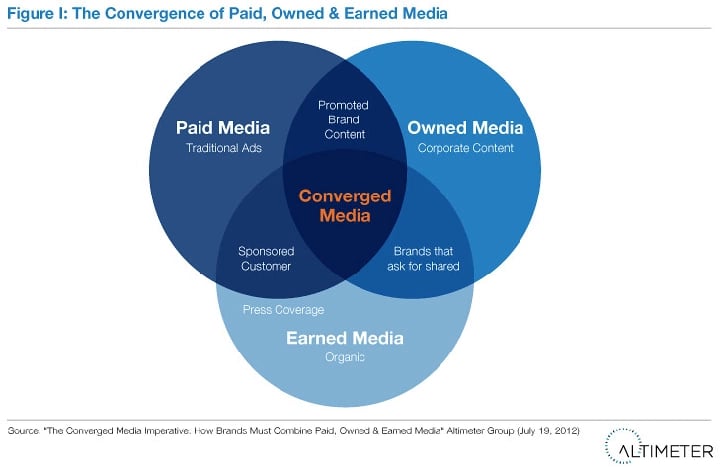
Typically, a digital marketing strategy is supported by three kinds of channels – owned, earned, and paid. Owned media is that which you have full control over such as your website, e-commerce store, email list, or blog. Earned media is publicity you receive as a result of your marketing efforts on third-party channels. These could be other websites, blogs, or coverage in the press. Lastly, paid media is any publicity you have to pay for. Examples include Facebook ads, Instagram ads, and sponsored posts on Twitter or Pinterest.
5. Develop Marketing Plans
Based on all the steps defined above, you can develop marketing plans for specific promotional activities. We discuss the basic steps of creating a marketing plan below.
How To Develop a Marketing Plan
Finally, it all comes down to putting your marketing strategies into practice. Here are a few steps that can help you create a unique and well-defined marketing plan.
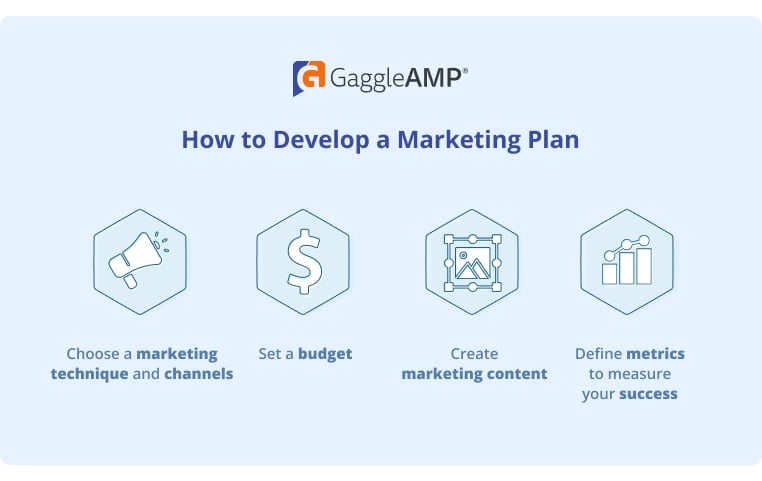
1. Define Your Marketing Technique and Channels
Based on your target customer base and other marketing goals, choose a technique that is likely to be most efficient at meeting your objectives. For instance, if your goal is to attract younger customers to your clothing brand, you would ideally choose to market your products via a combination of social media and influencer marketing. Similarly, you would choose a digital marketing channel to push your promotional activities instead of traditional media. You could choose from a wide variety of options such as:
- Social media marketing.
- SEO content marketing.
- Email marketing.
- Traditional paid media advertising (newspapers, billboards, and television).
- Sales promotions.
- Customer relationship marketing.
- Influencer marketing.
2. Set a Budget
Allocate enough money so that you can achieve your marketing goals. At the same time, make sure you don’t waste resources on marketing efforts that are unlikely to lead to any potential leads or sales. Ultimately, you must target a good return on your investments for your marketing efforts.
3. Create Marketing Content
At this stage, you should create marketing content that you can post to relevant channels. This could include material like videos, TV ads, posters, blog posts, photos, social media posts, reels, brochures, and flyers. Make sure you are accurate and consistent about your brand identity and values across different types of content and platforms.
4. Quantify Your Success
Like other business initiatives, your marketing plan needs to be analyzed and measured to determine its success or failure. This will also help you make changes to future plans. Metrics like ROI, return on ad spend (ROAS), conversion rate, cost per lead, cost per acquisition, website traffic, and click-through rate can help you analyze the success of your campaign.
Design Your Brand Strategy
Now that you know how to create a marketing strategy and plan, you are ready to develop these for your business! But how do you make sure that your marketing and sales teams are on the same page?
With GaggleAMP, you can ensure that your employees have access to consistent marketing goals so they can perform marketing-related activities on different social platforms like LinkedIn, Twitter, Facebook, and Instagram.
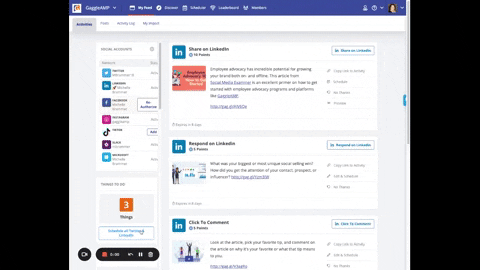
You can easily curate and share social media messaging with your team so that they can pitch in to amplify the visibility of your brand by advocating for it on different platforms. Our analytics dashboard makes it easy for you to measure the success of your various marketing endeavors.
Request a GaggleAMP demo to learn more about us today!











